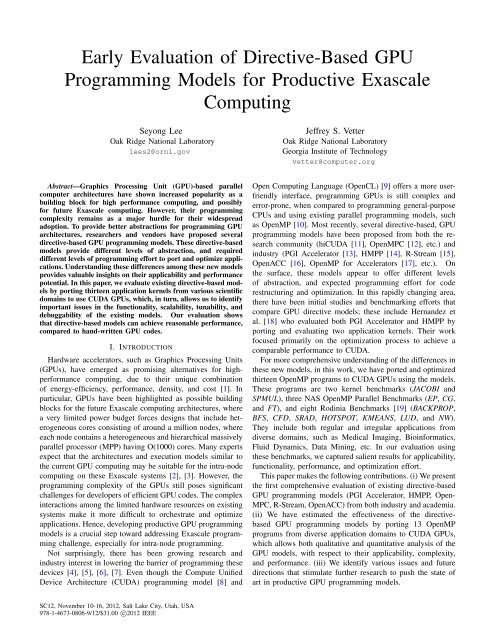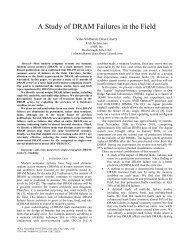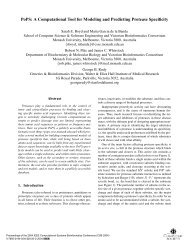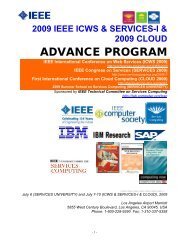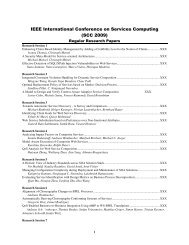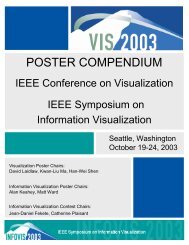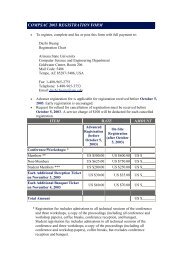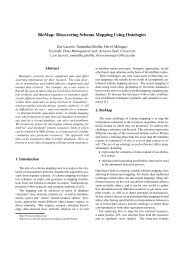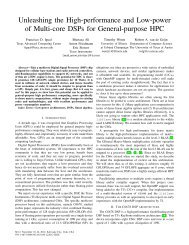Early Evaluation of Directive-Based GPU Programming Models for ...
Early Evaluation of Directive-Based GPU Programming Models for ...
Early Evaluation of Directive-Based GPU Programming Models for ...
Create successful ePaper yourself
Turn your PDF publications into a flip-book with our unique Google optimized e-Paper software.
<strong>Early</strong> <strong>Evaluation</strong> <strong>of</strong> <strong>Directive</strong>-<strong>Based</strong> <strong>GPU</strong><br />
<strong>Programming</strong> <strong>Models</strong> <strong>for</strong> Productive Exascale<br />
Computing<br />
Seyong Lee<br />
Oak Ridge National Laboratory<br />
lees2@ornl.gov<br />
Abstract—Graphics Processing Unit (<strong>GPU</strong>)-based parallel<br />
computer architectures have shown increased popularity as a<br />
building block <strong>for</strong> high per<strong>for</strong>mance computing, and possibly<br />
<strong>for</strong> future Exascale computing. However, their programming<br />
complexity remains as a major hurdle <strong>for</strong> their widespread<br />
adoption. To provide better abstractions <strong>for</strong> programming <strong>GPU</strong><br />
architectures, researchers and vendors have proposed several<br />
directive-based <strong>GPU</strong> programming models. These directive-based<br />
models provide different levels <strong>of</strong> abstraction, and required<br />
different levels <strong>of</strong> programming ef<strong>for</strong>t to port and optimize applications.<br />
Understanding these differences among these new models<br />
provides valuable insights on their applicability and per<strong>for</strong>mance<br />
potential. In this paper, we evaluate existing directive-based models<br />
by porting thirteen application kernels from various scientific<br />
domains to use CUDA <strong>GPU</strong>s, which, in turn, allows us to identify<br />
important issues in the functionality, scalability, tunability, and<br />
debuggability <strong>of</strong> the existing models. Our evaluation shows<br />
that directive-based models can achieve reasonable per<strong>for</strong>mance,<br />
compared to hand-written <strong>GPU</strong> codes.<br />
I. INTRODUCTION<br />
Hardware accelerators, such as Graphics Processing Units<br />
(<strong>GPU</strong>s), have emerged as promising alternatives <strong>for</strong> highper<strong>for</strong>mance<br />
computing, due to their unique combination<br />
<strong>of</strong> energy-efficiency, per<strong>for</strong>mance, density, and cost [1]. In<br />
particular, <strong>GPU</strong>s have been highlighted as possible building<br />
blocks <strong>for</strong> the future Exascale computing architectures, where<br />
a very limited power budget <strong>for</strong>ces designs that include heterogeneous<br />
cores consisting <strong>of</strong> around a million nodes, where<br />
each node contains a heterogeneous and hierarchical massively<br />
parallel processor (MPP) having O(1000) cores. Many experts<br />
expect that the architectures and execution models similar to<br />
the current <strong>GPU</strong> computing may be suitable <strong>for</strong> the intra-node<br />
computing on these Exascale systems [2], [3]. However, the<br />
programming complexity <strong>of</strong> the <strong>GPU</strong>s still poses significant<br />
challenges <strong>for</strong> developers <strong>of</strong> efficient <strong>GPU</strong> codes. The complex<br />
interactions among the limited hardware resources on existing<br />
systems make it more difficult to orchestrate and optimize<br />
applications. Hence, developing productive <strong>GPU</strong> programming<br />
models is a crucial step toward addressing Exascale programming<br />
challenge, especially <strong>for</strong> intra-node programming.<br />
Not surprisingly, there has been growing research and<br />
industry interest in lowering the barrier <strong>of</strong> programming these<br />
devices [4], [5], [6], [7]. Even though the Compute Unified<br />
Device Architecture (CUDA) programming model [8] and<br />
SC12, November 10-16, 2012, Salt Lake City, Utah, USA<br />
978-1-4673-0806-9/12/$31.00 c○2012 IEEE<br />
Jeffrey S. Vetter<br />
Oak Ridge National Laboratory<br />
Georgia Institute <strong>of</strong> Technology<br />
vetter@computer.org<br />
Open Computing Language (OpenCL) [9] <strong>of</strong>fers a more userfriendly<br />
interface, programming <strong>GPU</strong>s is still complex and<br />
error-prone, when compared to programming general-purpose<br />
CPUs and using existing parallel programming models, such<br />
as OpenMP [10]. Most recently, several directive-based, <strong>GPU</strong><br />
programming models have been proposed from both the research<br />
community (hiCUDA [11], OpenMPC [12], etc.) and<br />
industry (PGI Accelerator [13], HMPP [14], R-Stream [15],<br />
OpenACC [16], OpenMP <strong>for</strong> Accelerators [17], etc.). On<br />
the surface, these models appear to <strong>of</strong>fer different levels<br />
<strong>of</strong> abstraction, and expected programming ef<strong>for</strong>t <strong>for</strong> code<br />
restructuring and optimization. In this rapidly changing area,<br />
there have been initial studies and benchmarking ef<strong>for</strong>ts that<br />
compare <strong>GPU</strong> directive models; these include Hernandez et<br />
al. [18] who evaluated both PGI Accelerator and HMPP by<br />
porting and evaluating two application kernels. Their work<br />
focused primarily on the optimization process to achieve a<br />
comparable per<strong>for</strong>mance to CUDA.<br />
For more comprehensive understanding <strong>of</strong> the differences in<br />
these new models, in this work, we have ported and optimized<br />
thirteen OpenMP programs to CUDA <strong>GPU</strong>s using the models.<br />
These programs are two kernel benchmarks (JACOBI and<br />
SPMUL), three NAS OpenMP Parallel Benchmarks (EP, CG,<br />
and FT), and eight Rodinia Benchmarks [19] (BACKPROP,<br />
BFS, CFD, SRAD, HOTSPOT, KMEANS, LUD, and NW).<br />
They include both regular and irregular applications from<br />
diverse domains, such as Medical Imaging, Bioin<strong>for</strong>matics,<br />
Fluid Dynamics, Data Mining, etc. In our evaluation using<br />
these benchmarks, we captured salient results <strong>for</strong> applicability,<br />
functionality, per<strong>for</strong>mance, and optimization ef<strong>for</strong>t.<br />
This paper makes the following contributions. (i) We present<br />
the first comprehensive evaluation <strong>of</strong> existing directive-based<br />
<strong>GPU</strong> programming models (PGI Accelerator, HMPP, Open-<br />
MPC, R-Stream, OpenACC) from both industry and academia.<br />
(ii) We have estimated the effectiveness <strong>of</strong> the directivebased<br />
<strong>GPU</strong> programming models by porting 13 OpenMP<br />
programs from diverse application domains to CUDA <strong>GPU</strong>s,<br />
which allows both qualitative and quantitative analysis <strong>of</strong> the<br />
<strong>GPU</strong> models, with respect to their applicability, complexity,<br />
and per<strong>for</strong>mance. (iii) We identify various issues and future<br />
directions that stimulate further research to push the state <strong>of</strong><br />
art in productive <strong>GPU</strong> programming models.
The rest <strong>of</strong> this paper is organized as follows: Section II<br />
provides an overview <strong>of</strong> the <strong>GPU</strong> architecture, and section III<br />
presents directive-based <strong>GPU</strong> programming models. <strong>Evaluation</strong><br />
methodology, experimental results, and discussions are<br />
described in Section IV, Section V, and Section VI, respectively,<br />
and the conclusion will be presented in Section VII.<br />
II. OVERVIEW OF <strong>GPU</strong> ARCHITECTURE AND CUDA<br />
PROGRAMMING MODEL<br />
<strong>GPU</strong>s are general-purpose multi-threaded single instruction,<br />
multiple data (SIMD) architectures that are configured as<br />
a set <strong>of</strong> multiprocessors, each <strong>of</strong> which contains a set <strong>of</strong><br />
SIMD processing units. In <strong>GPU</strong> programming models, such as<br />
CUDA and OpenCL, a <strong>GPU</strong> is viewed as a parallel computing<br />
coprocessor attached to a host CPU, and it can execute a large<br />
number <strong>of</strong> threads concurrently. A <strong>GPU</strong> program consists <strong>of</strong><br />
a series <strong>of</strong> sequential and parallel regions. Sequential regions<br />
have little or no parallelism; they are executed on the CPU as<br />
serial codes. Parallel regions containing abundant parallelism<br />
are implemented as a set <strong>of</strong> kernel functions, which are<br />
executed on the <strong>GPU</strong> by a set <strong>of</strong> threads in an SIMD manner.<br />
In the CUDA model, <strong>GPU</strong> threads are grouped as a grid<br />
<strong>of</strong> thread blocks, each <strong>of</strong> which is mapped to a streaming<br />
multiprocessor (SM) in the <strong>GPU</strong>. Threads within each thread<br />
block are mapped to SIMD processing units in the SM. The<br />
configuration <strong>of</strong> <strong>GPU</strong> threads are specified through language<br />
extensions at each kernel invocation.<br />
The CUDA programming model assumes separate address<br />
spaces <strong>for</strong> a host CPU and a <strong>GPU</strong> device. The CUDA<br />
model provides a rich set <strong>of</strong> APIs <strong>for</strong> explicit <strong>GPU</strong> memory<br />
management, including functions to transfer data between the<br />
CPU and the <strong>GPU</strong>.<br />
The CUDA memory model has an <strong>of</strong>f-chip global memory<br />
space, which is accessible by all threads, a fast on-chip shared<br />
memory space, which is shared only by threads in the same<br />
thread block, an <strong>of</strong>f-chip local memory space, and registers,<br />
which are private to each thread.<br />
CUDA and other <strong>GPU</strong> models support multiple levels <strong>of</strong><br />
parallelism, but each parallelism differs in its synchronization<br />
support, which <strong>of</strong>ten sets a limit on the types <strong>of</strong> applications<br />
that can exploit the abundant computing powers in <strong>GPU</strong>s.<br />
III. DIRECTIVE-BASED, HIGH-LEVEL <strong>GPU</strong><br />
PROGRAMMING MODELS<br />
General directive-based programming systems consist <strong>of</strong><br />
directives, library routines, and designated compilers. In the<br />
directive-based <strong>GPU</strong> programming models, a set <strong>of</strong> directives<br />
are used to augment in<strong>for</strong>mation available to the designated<br />
compilers, such as guidance on mapping <strong>of</strong> loops onto <strong>GPU</strong><br />
and data sharing rules. The most important advantage <strong>of</strong> using<br />
directive-based <strong>GPU</strong> programming models is that they provide<br />
very high-level abstraction on <strong>GPU</strong> programming, since the<br />
designated compiler hides most <strong>of</strong> the complex details specific<br />
to the underlying <strong>GPU</strong> architectures. Another benefit is that<br />
the directive approaches make it easy to do incremental<br />
parallelization <strong>of</strong> applications, like OpenMP, such that a user<br />
can specify regions <strong>of</strong> a host program to be <strong>of</strong>floaded to a<br />
<strong>GPU</strong> device in an incremental way, and then the compiler<br />
automatically creates corresponding host+device programs.<br />
There exist several directive-based <strong>GPU</strong> programming models<br />
[11], [12], [13], [14], [15], [16], [17]. These models provide<br />
different levels <strong>of</strong> abstraction, and programming ef<strong>for</strong>ts<br />
required to con<strong>for</strong>m to their models and optimize the per<strong>for</strong>mance<br />
also vary. To understand the level <strong>of</strong> the abstraction<br />
that each directive-based model gives, Table I summarizes<br />
the type <strong>of</strong> in<strong>for</strong>mation that <strong>GPU</strong> directives can provide.<br />
The table says that R-Stream <strong>of</strong>fers the highest abstraction<br />
among the compared models, since in the R-Stream model, the<br />
compiler covers most features implicitly, without a programmer’s<br />
involvement. The table also implies that hiCUDA seems<br />
to provide the lowest level <strong>of</strong> abstraction among the tested<br />
models, since programmers should control most <strong>of</strong> the features<br />
explicitly. However, lower level <strong>of</strong> abstraction is not always<br />
bad, since low level <strong>of</strong> abstraction may allow enough control<br />
over various optimizations and the features specific to the<br />
underlying <strong>GPU</strong>s to achieve optimal per<strong>for</strong>mance. Moreover,<br />
actual programming ef<strong>for</strong>ts required to use each model may<br />
not be directly related to the level <strong>of</strong> abstraction that the model<br />
<strong>of</strong>fers, and high-level abstraction <strong>of</strong> a model sometimes puts<br />
limits on its application coverage. For better understanding<br />
<strong>of</strong> these issues, the following subsections give more detailed<br />
overview <strong>of</strong> each model that is evaluated in this paper.<br />
A. PGI Accelerator<br />
1) <strong>Programming</strong> Model: The PGI Accelerator programming<br />
model [13] is a directive-based model targeting general<br />
hardware accelerators, even though it currently supports<br />
only CUDA <strong>GPU</strong>s. The PGI model allows very high-level<br />
abstraction similar to OpenMP; at the minimum level, the<br />
user just has to specify regions, called Accelerator Compute<br />
Regions, where loops will be compiled into accelerator kernels.<br />
The user can do this by inserting directives into the host<br />
program without any additional modification on the original<br />
code structures; all the other details, such as actual acceleratorkernel-code<br />
generation, accelerator initialization, data transfers<br />
between a host and an accelerator, or accelerator startup and<br />
shutdown, are handled by the PGI Accelerator compiler. The<br />
PGI model also allows users to provide additional in<strong>for</strong>mation<br />
to the compilers, including specification <strong>of</strong> data local to an<br />
accelerator region, bounds <strong>of</strong> accessed arrays, guidance on<br />
mapping <strong>of</strong> loops onto an accelerator, and so on.<br />
The PGI Accelerator directives can be categorized as two<br />
types: directives <strong>for</strong> managing parallelism and those <strong>for</strong> managing<br />
data. The directives <strong>for</strong> parallelism guide types <strong>of</strong><br />
parallelism to execute loops, and the ones <strong>for</strong> data deal with<br />
data traffic between the host and the accelerator. One noble<br />
feature in the PGI Accelerator model is the data region. The<br />
data region sets boundaries where data are moved between<br />
the host and the accelerator; if a single data region encloses<br />
many compute regions, the compute regions can reuse the<br />
data already allocated on the accelerator. This can dramatically
TABLE I<br />
FEATURE TABLE, WHICH SHOWS THE TYPE OF INFORMATION THAT <strong>GPU</strong> DIRECTIVES CAN PROVIDE. IN THE TABLE, explicit MEANS THAT DIRECTIVES<br />
EXIST TO CONTROL THE FEATURE EXPLICITLY, implicit INDICATES THAT THE COMPILER IMPLICITLY HANDLES THE FEATURE, indirect SHOWS THAT<br />
USERS CAN INDIRECTLY CONTROL THE COMPILER FOR THE FEATURE, AND imp-dep MEANS THAT THE FEATURE IS IMPLEMENTATION-DEPENDENT.<br />
Features PGI OpenACC HMPP OpenMPC hiCUDA R-Stream<br />
Code regions to be <strong>of</strong>floaded loops structured loops structured structured loops<br />
blocks<br />
blocks blocks<br />
Loop mapping parallel parallel parallel parallel parallel parallel<br />
vector vector<br />
Data management<br />
<strong>GPU</strong> memory allocation and free explicit<br />
implicit<br />
explicit<br />
implicit<br />
explicit<br />
implicit<br />
explicit<br />
implicit<br />
explicit implicit<br />
Data movement between CPU and <strong>GPU</strong> explicit explicit explicit explicit explicit implicit<br />
implicit implicit implicit implicit<br />
Compiler optimizations<br />
Loop trans<strong>for</strong>mations<br />
Data management optimizations<br />
implicit<br />
explicit<br />
imp-dep<br />
imp-dep<br />
explicit<br />
explicit<br />
explicit<br />
explicit implicit<br />
implicit<br />
implicit<br />
implicit<br />
implicit implicit<br />
<strong>GPU</strong>-specific features<br />
Thread batching indirect<br />
implicit<br />
indirect<br />
implicit<br />
explicit<br />
implicit<br />
explicit<br />
implicit<br />
explicit explicit<br />
implicit<br />
Utilization <strong>of</strong> special memories indirect indirect explicit explicit explicit implicit<br />
implicit imp-dep<br />
implicit<br />
reduce the overhead <strong>of</strong> data movement and is important <strong>for</strong><br />
optimized per<strong>for</strong>mance.<br />
2) Limitations: The PGI Accelerator model provides a<br />
powerful tool <strong>for</strong> managing data traffic between the host and<br />
the accelerator; using data regions properly annotated with<br />
data clauses, programmers can easily generate optimized data<br />
communication patterns. However, there was a practical limit<br />
in using data regions; data regions had to lexically contain<br />
compute regions. If those compute regions were in different<br />
procedures, they had to be inlined to get the benefit. This limit<br />
is lifted by using new directives such as reflected introduced<br />
<strong>for</strong> PGI Accelerator Fortran but still not fully implemented<br />
in PGI Accelerator C. The lexical scope issue exists in other<br />
parts too; if target loops have function calls, they can not be<br />
trans<strong>for</strong>med into accelerator kernels, unless called functions<br />
are simple enough to be automatically inlined by the compiler.<br />
The main limitation <strong>of</strong> the PGI model is that it does not<br />
provide enough control over various optimizations and translations;<br />
most <strong>of</strong> the optimizations are per<strong>for</strong>med by the compiler<br />
automatically, but programmers have little control over<br />
them. Another limitation is that it does not provide directives<br />
<strong>for</strong> architecture-specific features. For example, CUDA <strong>GPU</strong><br />
provides various special memories, such as shared, constant,<br />
and texture memories. Each memory has distinct features, and<br />
thus careful exploitation <strong>of</strong> these resources may be crucial <strong>for</strong><br />
optimal per<strong>for</strong>mance. However, current PGI model does not<br />
provide tools to control data mapping onto these memories.<br />
Lack <strong>of</strong> reduction clause may be also problematic. The compiler<br />
can detect simple scalar reduction patterns automatically,<br />
but if the reduction pattern is complex, the compiler either fails<br />
to detect or generates wrong output codes. Proper annotation<br />
<strong>of</strong> reduction patterns will be able to simplify the automatic<br />
reduction code generation.<br />
There are several implementation-specific limits; there is a<br />
limit on the maximum depth <strong>of</strong> nested loops that the compiler<br />
can handle, and pointer arithmetic is not allowed within loops<br />
to be <strong>of</strong>floaded to the accelerator.<br />
B. OpenACC<br />
1) <strong>Programming</strong> Model: OpenACC [16], which is initiated<br />
by a consortium <strong>of</strong> CAPS, CRAY, PGI, and NVIDIA, is<br />
the first standardization ef<strong>for</strong>t toward a directive-based, general<br />
accelerator programming model portable across device<br />
types and compiler vendors. In this paper, we tested PGI’s<br />
implementation <strong>of</strong> OpenACC. The OpenACC programming<br />
model is largely based on the PGI Accelerator programming<br />
model (cf. §III-A1), and thus it inherits most <strong>of</strong> important<br />
concepts in the PGI Accelerator model, such as data region<br />
and compute region. Like PGI Accelerator, OpenACC has<br />
two types <strong>of</strong> directives: directives <strong>for</strong> managing parallelism<br />
and directives <strong>for</strong> managing data. However, the OpenACC<br />
directives are further extended to express additional features<br />
not available in the PGI Accelerator model. First, OpenACC<br />
has two types <strong>of</strong> compute constructs: the kernels construct<br />
and parallel construct. The kernels construct defines a region<br />
whose execution behavior is very similar to the compute<br />
region in the PGI Accelerator model; the code in the kernels<br />
region will be divided by the compiler into a sequence <strong>of</strong><br />
kernels, such that each loop nest becomes a single kernel.<br />
The parallel construct is new to OpenACC. It also defines a<br />
compute region, but its behavior is more similar to OpenMP’s<br />
parallel region; the whole region will be compiled into a single<br />
kernel, which may contain one or more work-sharing loops.<br />
Second, OpenACC defines three levels <strong>of</strong> parallelism; gang,<br />
worker, and vector, while PGI Accelerator defines two levels:<br />
parallel and vector. Third, OpenACC has rich data clauses to<br />
optimize data movement across procedure boundary in more<br />
general ways than PGI Accelerator, applicable to both dummy<br />
arguments and global data without an explicit interface. Last,<br />
OpenACC has an explicit reduction clause <strong>for</strong> loops, while<br />
PGI Accelerator depends on the compiler to detect reduction<br />
operations implicitly.<br />
2) Limitations: Because the OpenACC model is based on<br />
the PGI Accelerator model, it has limits similar to those in<br />
the PGI model; the OpenACC model does not provide enough
control over various optimizations and translations, and it also<br />
does not <strong>of</strong>fer directives to express architecture-specific features.<br />
One OpenACC-specific limit is that OpenACC requires<br />
that data in a data clause should be contiguous in memory. In<br />
other words, if a multi-dimensional array consists <strong>of</strong> multiple,<br />
discontinuous chunks <strong>of</strong> data, programmers should change<br />
the memory layout by manually packing the arrays in their<br />
application’s memory allocation code. At the time <strong>of</strong> writing<br />
this paper, the only available OpenACC implementation is<br />
built on top <strong>of</strong> the PGI Accelerator compiler, and thus the<br />
tested OpenACC compiler also has the same limits as the PGI<br />
Accelerator compiler. Because there exist several features not<br />
explicitly defined in the OpenACC specification, such as ambiguity<br />
in handling nested loops where gang/worker/vector loops<br />
are mixed, it is expected that porting OpenACC programs<br />
from one vendor compiler to another may incur per<strong>for</strong>mance<br />
portability and other code translation issues.<br />
C. HMPP<br />
1) <strong>Programming</strong> Model: HMPP [14] is another directivebased,<br />
<strong>GPU</strong> programming model targeting both CUDA and<br />
OpenCL. It also provides very high-level abstraction on <strong>GPU</strong><br />
programming, similar to PGI Accelerator. HMPP model is<br />
based on the concept <strong>of</strong> codelets, functions that can be<br />
remotely executed on hardware accelerators like <strong>GPU</strong>s. A<br />
codelet is a pure function, which does not contain static or<br />
volatile variable declarations nor refer to any global variables<br />
except if these have been declared by a HMPP directive<br />
resident. The codelet does not return any value, and thus the<br />
result <strong>of</strong> the computation should be passed by some parameters<br />
given by reference. Because the codelet is a base unit containing<br />
computations to be <strong>of</strong>floaded to <strong>GPU</strong>s, porting existing<br />
applications using HMPP <strong>of</strong>ten requires manual modification<br />
<strong>of</strong> code structures, such as outlining <strong>of</strong> a code region or<br />
re-factoring existing functions. To minimize these additional<br />
code changes, HMPP also provides an alternative way, called<br />
region, with which programmers can annotate code blocks<br />
without outlining to a codelet. However, the same constraints<br />
<strong>for</strong> writing codelets are applied to regions. For optimized data<br />
management, HMPP uses the concept <strong>of</strong> a group <strong>of</strong> codelets.<br />
By grouping a set <strong>of</strong> codelets, data in the <strong>GPU</strong> memory can<br />
be shared among different codelets, without any additional<br />
data transfers between CPU and <strong>GPU</strong>. Combining the codelet<br />
grouping with HMPP advancedload/delegatedstore directives<br />
allows the same data-transfer optimizations as the data region<br />
in the PGI model.<br />
One unique feature in the HMPP model is that the same<br />
codelet can be optimized differently depending on its call<br />
sites. The codelet/callsite directives can specify the use <strong>of</strong><br />
a codelet at a given point <strong>of</strong> a program, such that related<br />
data transfers and a target device can be changed according<br />
to the calling contexts. HMPP also provides a rich set <strong>of</strong><br />
directives, called HMPP Codelet Generator <strong>Directive</strong>s, which<br />
allow programmers high-level control over CUDA-specific<br />
features, such as CUDA special memories, in addition to<br />
complex loop mapping and loop trans<strong>for</strong>mations.<br />
2) Limitations: The concept <strong>of</strong> the HMPP codelet is<br />
unique; it defaults to a ”buffer” memory mode, where <strong>GPU</strong><br />
memory is allocated per codelet parameter, but not per host<br />
variable accessed by <strong>GPU</strong>, as in other <strong>GPU</strong> programming<br />
models. There<strong>for</strong>e, in the HMPP codelet model, if two<br />
different host variables are passed to the same codelet parameter<br />
at different call sites, the two host variables will share<br />
the same <strong>GPU</strong> memory. This <strong>GPU</strong> memory sharing is good<br />
<strong>for</strong> saving <strong>GPU</strong> memory, but it may cause additional data<br />
transfers between CPU and <strong>GPU</strong> if the two host variables<br />
are passed to the same codelet in an interleaved manner,<br />
since later codelet call will overwrite previous data in the<br />
<strong>GPU</strong> memory. Another inefficiency occurs if the same host<br />
variable is passed to different codelets; in this case, separate<br />
<strong>GPU</strong> memory regions are allocated <strong>for</strong> each codelet, even<br />
though both codelets access the same host variable. To remove<br />
redundancy caused by duplicate <strong>GPU</strong> memory allocations,<br />
codelet parameters referring to the same host variable should<br />
be explicitly mapped using map or mapbyname directives, but<br />
this makes data sharing across codelets very verbose and errorprone.<br />
The data mirroring directives provide a simpler way to<br />
allocate <strong>GPU</strong> memory per host variable but not per codelet<br />
parameter. Even with the data mirroring directives, however,<br />
manual data-transfer optimizations in the HMPP model is still<br />
more verbose than other models, since the HMPP codelet<br />
model requires users to individually specify data-transfer rules<br />
<strong>for</strong> each codelet. In the PGI Accelerator/OpenACC models, on<br />
the contrary, data transfers <strong>for</strong> multiple compute regions can<br />
be controlled by one data region enclosing those regions.<br />
In the HMPP model, compiler optimizations are explicit<br />
in that they should be explicitly specified by users using a<br />
rich set <strong>of</strong> directives. However, the current HMPP compiler<br />
implementation implicitly per<strong>for</strong>ms some optimizations <strong>for</strong><br />
scalar variables, but if these optimizations conflict with user’s<br />
manual optimizations, it will incur unexpected errors.<br />
D. OpenMPC<br />
1) <strong>Programming</strong> Model: OpenMPC [12] is a programming<br />
system that uses a variant <strong>of</strong> OpenMP extended <strong>for</strong> CUDA<br />
<strong>GPU</strong> programming. OpenMPC consists <strong>of</strong> a standard OpenMP<br />
API plus a new set <strong>of</strong> directives and environment variables<br />
to control important CUDA-related parameters and optimizations.<br />
Because OpenMPC is based on OpenMP, it provides<br />
programmers with the same level <strong>of</strong> abstraction as OpenMP,<br />
and most <strong>of</strong> existing OpenMP programs can be ported to<br />
CUDA <strong>GPU</strong>s seamlessly. In OpenMPC, OpenMP parallel<br />
regions are the base candidates to be executed on the <strong>GPU</strong>, but<br />
the OpenMPC compiler may split each parallel region into two<br />
sub-regions at each explicit/implicit synchronization point, to<br />
en<strong>for</strong>ce OpenMP synchronization semantics under the CUDA<br />
programming model. Among the resulting sub-regions, the<br />
ones containing at least one OpenMP work-sharing construct<br />
will be trans<strong>for</strong>med to <strong>GPU</strong> kernels. OpenMPC does not have<br />
directives like PGI data region to set arbitrary boundaries<br />
where <strong>GPU</strong> memory is allocated and freed. Instead, users<br />
can set the whole program or each function as an implicit
oundary, using an OpenMPC environment variable, and then<br />
the compiler automatically optimizes the data management<br />
using context-sensitive, interprocedural analyses. For contextsensitive<br />
optimizations, the OpenMPC compiler per<strong>for</strong>ms automatic,<br />
selective procedure cloning, which has an effect<br />
similar to what the HMPP codelet/callsite directives <strong>of</strong>fer.<br />
OpenMPC also provides assorted data directives to control<br />
data transfer optimizations.<br />
The main advantage <strong>of</strong> using OpenMPC is that it allows<br />
fine-grained control over various compiler optimizations, execution<br />
configurations, and CUDA-specific features such as<br />
special CUDA on-chip memories. Combined with various<br />
built-in tuning tools, the rich set <strong>of</strong> directives enable an easy<br />
tuning environment that assists users in generating CUDA<br />
programs in many optimization variants without detailed<br />
knowledge <strong>of</strong> the complex <strong>GPU</strong> programing and memory<br />
models. One <strong>of</strong> OpenMPC’s unique features is that it supports<br />
both scalar and array reduction computations. Standard<br />
OpenMP has reduction clauses <strong>for</strong> scalar reduction operations.<br />
To express array reduction operations in OpenMP, the critical<br />
directives are commonly used. The OpenMPC compiler can<br />
automatically detect array reduction patterns in the OpenMP<br />
critical sections and trans<strong>for</strong>m them into appropriate <strong>GPU</strong><br />
reduction codes. Additionally, reduction clauses in OpenMPC<br />
accept both scalar and array reduction variables.<br />
2) Limitations: The OpenMPC model is extended from the<br />
OpenMP model. However, not all OpenMP semantics can<br />
be correctly preserved in the CUDA programming model,<br />
due to the architectural differences between traditional shared<br />
memory multiprocessors, served by OpenMP, and stream<br />
architectures, adopted by <strong>GPU</strong>s. Code regions containing<br />
OpenMP features not implementable in the CUDA model will<br />
be executed on the host. Splitting OpenMP parallel regions<br />
at every synchronization point is an essential step to identify<br />
code regions suitable <strong>for</strong> execution on the <strong>GPU</strong>. However,<br />
the splitting may break the correctness <strong>of</strong> a program, if the<br />
splitting results in upward exposed private variables. The<br />
compiler automatically per<strong>for</strong>ms various trans<strong>for</strong>mations to<br />
remove this problem, but there are cases that the automatic<br />
trans<strong>for</strong>mations cannot fix. In these cases, the compiler will<br />
notify the problems, and programmers should manually restructure<br />
the code regions to avoid the problems.<br />
In the OpenMPC memory model, both OpenMP shared and<br />
threadprivate data are mapped to <strong>GPU</strong> global memory. However,<br />
current OpenMPC implementation allows only scalar or<br />
array types <strong>for</strong> these data. Converting a pointer-type variable<br />
to an array-type <strong>of</strong>ten requires outlining <strong>of</strong> OpenMP parallel<br />
regions. The burden <strong>of</strong> outlining will be removed if OpenMPC<br />
data clauses are extended such that programmers can specify<br />
the bounds <strong>of</strong> accessed data, as in other directive models.<br />
The OpenMPC compiler provides a variety <strong>of</strong> powerful<br />
interprocedural analyses, which enable advanced optimizations<br />
without manual inlining. However, some <strong>of</strong> the aggressive<br />
optimizations may not be safe, since they rely on arrayname-only<br />
analyses. The compiler does not guarantee the<br />
correctness <strong>of</strong> those optimizations, and thus users should check<br />
the correctness <strong>of</strong> the generated output codes. For this case,<br />
the compiler provides users with options to selectively apply<br />
these unsafe, aggressive optimizations.<br />
Another implementation-specific limit is that the current<br />
OpenMPC compiler can handle a multi-dimensional array<br />
correctly only if it is allocated as one continuous data layout,<br />
which constrains the way a user can allocate multi-dimensional<br />
dynamic arrays.<br />
E. R-Stream<br />
1) <strong>Programming</strong> Model: R-Stream [15] is a polyhedral<br />
model-based, high-level, architecture-independent programming<br />
model, which targets various architectures, such as STI<br />
Cell, SMP with OpenMP directives, Tilera, and CUDA <strong>GPU</strong>s.<br />
The R-Stream model is based on a polyhedral compiler that<br />
can automatically parallelize mappable regions <strong>of</strong> code that<br />
con<strong>for</strong>m to the extended static control program structure,<br />
which refers to a program that operates on dense matrices and<br />
arrays and that consists <strong>of</strong> <strong>for</strong> loops, whose bounds are integer<br />
affine functions, and arrays, whose indexing functions are also<br />
affine. In the R-Stream model, a user just has to specify which<br />
functions are valid mappable regions by tagging them with<br />
directives, and then the underlying compiler per<strong>for</strong>ms various<br />
complex loop analyses and trans<strong>for</strong>mations to automatically<br />
parallelize and optimize the mappable sequential codes <strong>for</strong> a<br />
target architecture.<br />
The R-Stream model is distinguished from other directivebased<br />
approaches in several ways. First, in the R-Stream<br />
model, the parallelization <strong>of</strong> the code is fully automatic;<br />
its powerful polyhedral compiler automatically captures dependency<br />
in the input code and per<strong>for</strong>ms necessary loop<br />
trans<strong>for</strong>mations to maximize the parallelism, while other existing<br />
approaches are semi-automatic in that they require the<br />
programmer to explicitly specify necessary directives to guide<br />
the parallelization <strong>of</strong> the code either directly or indirectly.<br />
Second, R-Stream allows fully automatic management <strong>of</strong> the<br />
data transfers between the host and <strong>GPU</strong> and <strong>GPU</strong>-specific<br />
memories, such as CUDA shared memory. For this, the<br />
compiler per<strong>for</strong>ms hierarchical decomposition <strong>of</strong> the algorithm<br />
between and across host, multiple <strong>GPU</strong>s, and within-<strong>GPU</strong>,<br />
using hierarchical tiling. On the other hand, other works,<br />
except <strong>for</strong> OpenMPC, heavily rely on directives inserted by the<br />
programmer. OpenMPC provides automatic optimizations <strong>for</strong><br />
both the memory transfers between the CPU and <strong>GPU</strong>, and <strong>for</strong><br />
using <strong>GPU</strong>-specific memory, but it lacks tiling trans<strong>for</strong>mations<br />
as powerful as R-Stream. Third, R-Stream provides transparent<br />
porting across different architectures, while other approaches<br />
target only hardware accelerators, such as <strong>GPU</strong>s, and may not<br />
be per<strong>for</strong>mance portable. In R-Stream, the computation choreography<br />
needed <strong>for</strong> efficient execution on target architectures<br />
can be automatically constructed from the same sequential<br />
C source, and automatically rendered into the corresponding<br />
target-specific sources, such as OpenMP, CUDA, etc. This<br />
transparent mapping is possible due to a user-provided, declarative<br />
machine model, which provides the overall architecture<br />
topology as well as per<strong>for</strong>mance and capacity parameters; the
compiler uses the contents <strong>of</strong> the machine model to derive<br />
various optimization parameters and mapping tactics.<br />
2) Limitations: The R-Stream’s polyhedral framework provides<br />
an unprecedented level <strong>of</strong> loop trans<strong>for</strong>mations <strong>for</strong> more<br />
powerful parallelization and mapping capability than other<br />
existing approaches. However, it works only on regular programs<br />
with integer affine loop bounds and integer affine loop<br />
indexing, which are <strong>of</strong>ten too restrictive to be applied to real<br />
applications, as shown in the experimental results in Section V.<br />
There exist many regular scientific applications containing<br />
affine loops, each <strong>of</strong> which may be efficiently optimized by the<br />
R-Stream compiler. When porting non-trivial scientific applications<br />
into <strong>GPU</strong>s, however, the overhead <strong>of</strong> data movement<br />
between CPU and <strong>GPU</strong> can be a main per<strong>for</strong>mance bottleneck,<br />
since multiple <strong>GPU</strong> kernels are invoked across different callsites,<br />
resulting in complex communication patterns between<br />
CPU and <strong>GPU</strong>. For those applications, reducing redundant<br />
data transfers is critical <strong>for</strong> optimal per<strong>for</strong>mance. In the R-<br />
Stream model, to globally optimize the data movement across<br />
different mappable parallel regions, these regions should be put<br />
together into one function. However, if any unmappable code<br />
exists between the mappable regions, the R-Stream compiler<br />
cannot handle the resulting function. To deal with this issue,<br />
the R-Stream model provides a technique, called blackboxing,<br />
to mask unmappable code. In the current implementation,<br />
however, the blackboxing technique is not yet fully supported<br />
<strong>for</strong> porting to <strong>GPU</strong>s.<br />
The R-Stream model allows a user to control various loop<br />
trans<strong>for</strong>mations and communication optimizations <strong>for</strong> each<br />
mappable region, but not across different regions. To optimize<br />
the data transfers across different mappable regions, these<br />
regions should be merged into one function, as explained<br />
above. However, merging multiple regions may increase the<br />
mapping complexity <strong>of</strong> the underlying polyhedral model to the<br />
level that cannot be handled by the current R-Stream compiler.<br />
For the same reason, there is a practical limit on the maximum<br />
depth <strong>of</strong> nested loops.<br />
IV. EVALUATION METHODOLOGY<br />
For our evaluation, we selected thirteen OpenMP programs<br />
to port and optimize <strong>for</strong> CUDA <strong>GPU</strong>s using each <strong>of</strong> the<br />
programming models explained in Section III. These programs<br />
are two kernel benchmarks (JACOBI and SPMUL), three NAS<br />
OpenMP Parallel Benchmarks (EP, CG, and FT), and eight<br />
Rodinia Benchmarks [19] (BACKPROP, BFS, CFD, SRAD,<br />
HOTSPOT, KMEANS, LUD, and NW).<br />
Tested programs include both regular and irregular applications<br />
in diverse domains. Some <strong>of</strong> these programs are<br />
not considered ’<strong>GPU</strong>-friendly,’ but the diversity allows us<br />
to gain valuable insights on the application coverage. For<br />
programming models not accepting OpenMP directives, all<br />
OpenMP directives and library calls were either converted<br />
to their corresponding directives or removed from the input<br />
OpenMP programs. To achieve the best per<strong>for</strong>mance, additional<br />
directives were added <strong>for</strong> each programming model, and<br />
code structures <strong>of</strong> the input programs were also modified to<br />
meet the requirements and suggestions <strong>of</strong> each model. More<br />
details on the code changes <strong>of</strong> each program are explained in<br />
the following sections.<br />
We used a NVIDIA Tesla M2090 <strong>GPU</strong> as an experimental<br />
plat<strong>for</strong>m. The device has 512 streaming processors with clock<br />
rate at 1.3 GHz and has 6GB DRAM. The host system–<br />
Keeneland [1]–consists <strong>of</strong> eight Intel Xeon X5660 CPUs at<br />
2.8 GHz. Per<strong>for</strong>mance <strong>of</strong> each programming model was evaluated<br />
by measuring the speedups <strong>of</strong> output CUDA programs<br />
generated by each programming model. The speedups are over<br />
sequential CPU versions without OpenMP, compiled with the<br />
GCC compiler version 4.1.2 using option -O3. For CUDA<br />
compilation, NVIDIA Toolkit version 4.1 was used. For both<br />
PGI Accelerator and OpenACC, PGI compiler version 12.6<br />
was used, and <strong>for</strong> R-Stream, HMPP, and OpenMPC, version<br />
3.2RC1, 3.0.7, and 0.31 were used respectively. To compare<br />
against <strong>GPU</strong> per<strong>for</strong>mance upper bound, the hand-written<br />
CUDA versions <strong>of</strong> the tested programs were also evaluated;<br />
Rodinia Benchmarks have both OpenMP and CUDA versions,<br />
and thus CUDA versions in the benchmarks suite were used.<br />
The CUDA version <strong>of</strong> FT is from Hpcgpu Project [20], and<br />
<strong>for</strong> the remaining ones (JACOBI, SPMUL, EP, and CG), we<br />
created hand-tuned CUDA versions by converting from the<br />
OpenMP versions manually.<br />
TABLE II<br />
PROGRAM COVERAGE AND NORMALIZED, AVERAGE CODE-SIZE<br />
INCREASE. THE COVERAGE REPRESENTS THE PERCENTAGE OF OPENMP<br />
PARALLEL REGIONS TRANSLATED TO <strong>GPU</strong> KERNELS BY EACH MODEL<br />
(A/B FORMAT INDICATES THAT TESTED MODELS CAN CONVERT A OUT OF<br />
B OPENMP PARALLEL REGIONS INTO <strong>GPU</strong> CODES.) THE NORMALIZED<br />
CODE-SIZE INCREASE INDICATES HOW MUCH ADDITIONAL CODES, ON<br />
AVERAGE, SHOULD BE ADDED TO PORT THE INPUT OPENMP PROGRAMS<br />
INTO <strong>GPU</strong> USING EACH MODEL.<br />
<strong>GPU</strong> <strong>Models</strong> Program Coverage (%) Code-Size Increase (%)<br />
PGI Accelerator 98.3 (57/58) 18.2<br />
OpenACC 98.3 (57/58) 18<br />
HMPP 98.3 (57/58) 18.5<br />
OpenMPC 100 (58/58) 5.2<br />
R-Stream 37.9 (22/58) 9.5<br />
V. EXPERIMENTAL RESULTS<br />
Table II summarizes the program coverage and normalized<br />
code-size increase <strong>of</strong> each <strong>GPU</strong> programming model. The<br />
program coverage suggests that most <strong>of</strong> the existing <strong>GPU</strong><br />
models can translate computation patterns from various application<br />
domains. The R-Stream model has relatively low<br />
coverage, since it works only on regular affine programs.<br />
If its code-masking mechanism, called blackboxing, is properly<br />
used, its coverage may increase to the level similar<br />
to other models, but the current R-Stream compiler does<br />
not support the feature yet. The code-size increase refers<br />
to the normalized, average amount <strong>of</strong> additional codes that<br />
are needed to con<strong>for</strong>m to each programming model and to<br />
manually optimize data transfers between CPU and <strong>GPU</strong>.<br />
Even though the R-Stream model provides the highest level<br />
<strong>of</strong> abstraction, the required coding ef<strong>for</strong>t is not the smallest;<br />
to mask irregular codes, they should be outlined as separate
functions, and dummy affine functions, which summarize<br />
array access patterns <strong>of</strong> the original irregular codes, should<br />
be created to replace the outlined functions. The OpenMPC<br />
model has the least amount <strong>of</strong> code restructuring, since it<br />
supports function calls in <strong>GPU</strong> codes and per<strong>for</strong>ms selective<br />
procedure cloning automatically, which are <strong>of</strong>ten necessary<br />
<strong>for</strong> context-sensitive, global data-transfer optimizations; other<br />
models either do not support these features or support them<br />
in limited ways, and thus these models <strong>of</strong>ten request manual<br />
inlining/procedure cloning in the input codes. The table shows<br />
that HMPP, PGI Accelerator, and OpenACC have similar codesize<br />
increases, but required coding practices are different;<br />
the HMPP model does not support directives such as data<br />
regions in PGI Accelerator/OpenACC. Without data regions,<br />
the HMPP model requires to explicitly specify data-transfer<br />
rules <strong>for</strong> each codelet <strong>for</strong> manual optimizations, incurring<br />
more directives than PGI Accelerator/OpenACC. However,<br />
more explicit control combined with its own runtime support<br />
allows HMPP users to express context-sensitive, global datatransfer<br />
optimizations with less manual code restructuring than<br />
current PGI Accelerator/OpenACC implementations. In the<br />
tested benchmarks, these opposite coding practices balance out<br />
each other, resulting in similar code increases in these models.<br />
Figure 1 shows the overall per<strong>for</strong>mance <strong>of</strong> <strong>GPU</strong> programs<br />
translated by directive-based <strong>GPU</strong> compilers (The results <strong>for</strong><br />
R-Stream are excluded due to its low program coverage, which<br />
will be fixed once its masking mechanism becomes available.)<br />
Overall, directive-based <strong>GPU</strong> programming models in<br />
the figure achieve similar per<strong>for</strong>mance, which are sometimes<br />
better than the hand-written CUDA programs. More detailed<br />
explanations are presented in the following subsections.<br />
A. Per<strong>for</strong>mance <strong>of</strong> Kernel Benchmarks and NAS Parallel<br />
Benchmarks<br />
JACOBI is a widely used kernel constituting the main loop<br />
<strong>of</strong> an iterative method in regular scientific applications. In<br />
the original OpenMP version, the outermost loops <strong>of</strong> nested<br />
parallel computation loops are parallelized to minimize parallelization<br />
overheads such as OpenMP <strong>for</strong>k-join overheads. The<br />
same rule is applied <strong>for</strong> <strong>GPU</strong> computing; parallelizing the outermost<br />
loops will incur less <strong>GPU</strong> kernel invocation overheads<br />
than the other way. However, the PGI Accelerator/OpenACC<br />
versions following the OpenMP-style parallelization do not<br />
per<strong>for</strong>m well. This per<strong>for</strong>mance degradation is mostly due<br />
to the overhead in large, uncoalesced global memory access<br />
patterns. In OpenMPC, the compiler automatically changes<br />
the uncoalesced access patterns to coalesced ones by applying<br />
a loop-interchange technique called parallel loop-swap [21].<br />
In PGI Accelerator/OpenACC, if both outer and inner loops<br />
are annotated with parallel/gang clauses, the compiler can<br />
find a mapping between loop iterations and two-dimensional<br />
thread blocks allowing coalesced accesses. Moreover, the PGI<br />
compiler automatically applies tiling trans<strong>for</strong>mation to exploit<br />
<strong>GPU</strong> shared memory. The manual CUDA version applies the<br />
same tiling trans<strong>for</strong>mation as the PGI compiler. The best<br />
per<strong>for</strong>mance <strong>of</strong> the PGI Accelerator/OpenACC versions is<br />
achieved when the parallel loop-swap technique is manually<br />
applied, and only the outermost loops are parallelized. HMPP<br />
version also applies the same techniques, but these trans<strong>for</strong>mations<br />
can be fully expressed using its directives, since it<br />
provides rich set <strong>of</strong> directives <strong>for</strong> various loop trans<strong>for</strong>mations.<br />
Embarrassingly Parallel (EP) is one <strong>of</strong> NAS OpenMP<br />
Parallel Benchmarks. EP has abundant parallelism with minimal<br />
communication; it is <strong>of</strong>ten used to demonstrate the<br />
per<strong>for</strong>mance <strong>of</strong> parallel computing systems. To port EP using<br />
the PGI Accelerator model, several modifications on the<br />
code structure are needed; first, EP has one parallel region<br />
containing an omp <strong>for</strong> loop and omp critical section, but the<br />
PGI Accelerator compiler cannot parallelize general structured<br />
blocks, and it also does not understand the concept <strong>of</strong> critical<br />
sections. There<strong>for</strong>e, the parallel region should be converted to<br />
an explicit parallel loop. Second, the critical section per<strong>for</strong>ms<br />
array reduction computation, but the PGI Accelerator model<br />
can handle only scalar reductions, and thus the array reduction<br />
should be manually decomposed to a set <strong>of</strong> scalar reductions.<br />
Third, EP uses a private array to keep internal outputs computed<br />
by each thread. In the PGI Accelerator model, the private<br />
array is allocated in the <strong>GPU</strong> global memory <strong>for</strong> each thread.<br />
However, if the number <strong>of</strong> threads are too big, the allocation<br />
<strong>of</strong> the private array causes a memory overflow. In the PGI<br />
Accelerator model, a user can control the size <strong>of</strong> a thread<br />
block indirectly, but the number <strong>of</strong> thread blocks are implicitly<br />
decided based on the size <strong>of</strong> thread block and the size <strong>of</strong> loop<br />
iteration space. There<strong>for</strong>e, to prevent the memory overflow,<br />
programmers should manually strip-mine the parallel loop to<br />
reduce the size <strong>of</strong> the loop iteration space. To port using the<br />
other models except <strong>for</strong> OpenMPC, code modifications similar<br />
to those <strong>for</strong> PGI Accelerator were applied.<br />
Figure 1 shows that OpenMPC outper<strong>for</strong>ms the other directive<br />
models; the main reason <strong>for</strong> this per<strong>for</strong>mance gap lies<br />
in the difference in allocating the private array. All versions<br />
use an array expansion technique to privatize an array, but in<br />
different manners; the PGI Accelerator compiler expands the<br />
array in a row-wise fashion, while the OpenMPC compiler<br />
does it in a column-wise fashion using the technique called<br />
Matrix transpose [21]. The row-wise expansion is a technique<br />
commonly used in shared memory systems, since it increases<br />
intra-thread locality. However, it causes an uncoalesced memory<br />
access problems when applied in the CUDA memory<br />
model. On the other hand, column-wise expansion expands an<br />
array in a way to increase inter-thread locality, which allows<br />
coalesced memory accesses in the CUDA memory model. If<br />
the Matrix Transpose technique is manually applied to the<br />
other models, instead <strong>of</strong> using their private clauses, they also<br />
per<strong>for</strong>m similarly to the OpenMPC version.<br />
The per<strong>for</strong>mance gap between the OpenMPC version and<br />
the manual CUDA version is due to the difference in handling<br />
a critical section per<strong>for</strong>ming an array reduction; both the<br />
OpenMPC version and manual version convert the critical<br />
section into array reduction code, but the manual version<br />
optimizes further by removing a redundant private array, which<br />
was used as a local reduction variable.
Speedup<br />
1000<br />
100<br />
10<br />
1<br />
0.1<br />
JACOBI<br />
EP<br />
512 PGI Accelerator<br />
OpenACC<br />
HMPP<br />
OpenMPC<br />
Hand-Written CUDA<br />
Per<strong>for</strong>mance Variation By Tuning<br />
448<br />
SPMUL<br />
CG<br />
FT<br />
SRAD<br />
CFD<br />
Benchmark<br />
BFS<br />
HOTSPOT<br />
BACKPROP<br />
Fig. 1. Per<strong>for</strong>mance <strong>of</strong> <strong>GPU</strong> programs translated by directive-based <strong>GPU</strong> compilers. Speedups are over serial on the CPU, when the largest available input<br />
data were used<br />
Sparse matrix-vector (SpMV) multiplication is an important<br />
representative <strong>of</strong> irregular applications. The SPMUL kernel<br />
and the NAS Parallel Benchmark CG are two important<br />
applications per<strong>for</strong>ming the SpMV computations.<br />
While both CG and SPMUL use similar SpMV multiplication<br />
algorithms, CG poses additional challenges. In CG,<br />
many parallel loops span across several procedures, resulting<br />
in complex memory transfer patterns between the CPU and<br />
<strong>GPU</strong>. While OpenMPC per<strong>for</strong>ms these communication optimizations<br />
automatically through its built-in interprocedural<br />
data flow analyses, all the other <strong>GPU</strong> models demand extensive<br />
use <strong>of</strong> data clauses to optimize the complex communication<br />
patterns. The OpenMPC version outper<strong>for</strong>ms the other ones,<br />
mainly due to a loop trans<strong>for</strong>mation technique called loop<br />
collapsing [21], which addresses uncoalesced access problems<br />
caused by indirect accesses and control flow divergences in<br />
the CG. Contrary to OpenMPC, the PGI Accelerator compiler<br />
uses <strong>GPU</strong> shared memory extensively in order to alleviate the<br />
uncoalesced memory access problems.<br />
The NAS OpenMP Parallel Benchmark FT solves a 3-<br />
D partial differential equation using the Fast Fourier Trans<strong>for</strong>m<br />
(FFT). The original OpenMP version heavily uses data<br />
blocking to exploit intra-thread locality on traditional, cachebased<br />
systems. Moreover, <strong>for</strong> the best intra-thread locality,<br />
nested loops per<strong>for</strong>ming FFT are parallelized across 3rd or<br />
2nd dimensions, instead <strong>of</strong> 1st dimension. However, this data<br />
partitioning scheme allows little opportunity <strong>for</strong> coalesced<br />
global memory accesses.<br />
The hand-written CUDA version applies a different data<br />
partitioning scheme; it transposes the whole 3-D matrix so<br />
that 1st dimension is always parallelized <strong>for</strong> all 1-D FFT<br />
computations. It also linearizes all 2-D and 3-D arrays to<br />
reduce memory-address-computation overhead. These changes<br />
may not be easy to be automated by compilers, but can be<br />
KMEANS<br />
applied to the input OpenMP code. After the input code<br />
modifications, all the <strong>GPU</strong> models achieve the per<strong>for</strong>mance<br />
comparable to the hand-written CUDA version.<br />
NW<br />
B. Per<strong>for</strong>mance <strong>of</strong> Rodinia Benchmarks<br />
SRAD per<strong>for</strong>ms a diffusion method called Speckle Reducing<br />
Anisotropic Diffusion (SRAD) to remove locally correlated<br />
noise in ultrasonic and radar imaging applications based on<br />
partial differential equations. The OpenMPC version uses<br />
a parallel loop-swap optimization to achieve the coalesced<br />
accesses, while the other models rely on multi-dimensional<br />
loop partitioning, as in the manual version. The manual version<br />
applies an additional optimization to reduce the number <strong>of</strong><br />
global memory accesses; the original OpenMP version uses<br />
subscript arrays to store index expressions <strong>for</strong> subscripted<br />
arrays, but the manual version calculates the index expressions<br />
directly to remove global memory accesses to read the subscript<br />
arrays. However, this optimization increases the amount<br />
<strong>of</strong> computations and control flow divergences <strong>for</strong> calculating<br />
the index expressions. The experimental results reveal that<br />
the per<strong>for</strong>mance gain by reducing global memory accesses<br />
are overwhelmed by the overhead <strong>of</strong> additional control flow<br />
divergences.<br />
Breadth-First Search (BFS) is one <strong>of</strong> fundamental graph<br />
algorithms widely used in many scientific and engineering<br />
applications. Even though it has a very simple algorithm,<br />
its irregular access patterns using a subscript array make it<br />
difficult to achieve per<strong>for</strong>mance on the <strong>GPU</strong>. There<strong>for</strong>e, none<br />
<strong>of</strong> tested models achieved reasonable per<strong>for</strong>mance. There exist<br />
a <strong>GPU</strong> implementation [22] per<strong>for</strong>ming better than classical<br />
CPU implementation. However, the algorithms in the <strong>GPU</strong><br />
implementation are not expressible in directive-based models.<br />
CFD is an unstructured grid finite volume solver <strong>for</strong> the<br />
three-dimensional Euler equations <strong>for</strong> compressible flow. The<br />
LUD
naive translation using directive models has some speedups<br />
but much less than the manual version. The per<strong>for</strong>mance<br />
gap is largely due to the uncoalesced global memory accesses.<br />
CFD uses several two-dimensional matrix data, and<br />
accessing these matrices causes uncoalesced memory access<br />
problems. However, it is very difficult <strong>for</strong> a compiler to fix<br />
the problem automatically, since the matrices are stored in<br />
one-dimensional arrays and accessed using complex subscript<br />
expressions. The manual version modifies the layout <strong>of</strong> these<br />
two-dimensional data stored in one-dimensional arrays and<br />
changes the corresponding array subscript expressions in a<br />
way to enable coalesced memory accesses. After these changes<br />
were manually applied to the input OpenMP codes, <strong>GPU</strong><br />
models could achieve similar per<strong>for</strong>mance to the manual<br />
CUDA version. The OpenMPC version per<strong>for</strong>ms better than<br />
the other ones mainly due to more fine-grained data caching<br />
to exploit both constant cache and texture cache.<br />
HOTSPOT is a tool to estimate processor temperature based<br />
on an architectural floorplan and simulated power measurements.<br />
The original OpenMP program contains two parallel<br />
loops, and each loop has a nested inner loop, which is<br />
also parallelizable. Parallelizing the outer loops as expressed<br />
in the original OpenMP program does not provide enough<br />
number <strong>of</strong> threads to hide the global memory latency. The<br />
manual version uses a two-dimensional partitioning scheme to<br />
increase the number <strong>of</strong> threads. It also use tiling trans<strong>for</strong>mation<br />
to exploit shared memory. The OpenMPC model does not<br />
support multi-dimensional partitioning scheme. Rather, it uses<br />
the OpenMP collapse clause to produce a similar effect.<br />
Other <strong>GPU</strong> models used manual collapsing instead <strong>of</strong> multidimensioning<br />
partitioning, since some necessary features are<br />
not yet implemented.<br />
Back Propagation (BACKPROP) is a machine-learning algorithm<br />
that trains the weights <strong>of</strong> connecting nodes on a layered<br />
neural network. In OpenMPC, naive translation <strong>of</strong> BACKPROP<br />
per<strong>for</strong>ms very poorly, due to uncoalesced accesses. In fact, the<br />
parallel loop-swap technique can fix the uncoalesced global<br />
memory access problems. However, the current OpenMPC<br />
compiler could not per<strong>for</strong>m the optimization automatically due<br />
to its complexity. There<strong>for</strong>e, the technique had to be applied<br />
manually.<br />
In other models, code trans<strong>for</strong>mations similar to OpenMPC<br />
version were applied. Moreover, to avoid array reduction,<br />
which occurs as a side-effect <strong>of</strong> the memory layout change<br />
but cannot be handled by these models, some nested parallel<br />
loops had to be manually trans<strong>for</strong>med further.<br />
K-Means (KMEANS) is a clustering algorithm used extensively<br />
in data-mining and many other areas. It has reduction<br />
patterns, but the original OpenMP version does not use<br />
OpenMP reduction clauses, since OpenMP does not support<br />
array reductions. Instead, the OpenMP version uses expanded<br />
arrays <strong>for</strong> each thread to hold its partial output, and the<br />
final reduction is per<strong>for</strong>med by the CPU. Most <strong>GPU</strong> models<br />
use the original pattern, but <strong>for</strong> OpenMPC, the reduction<br />
patterns were changed to OpenMP critical sections so that<br />
the OpenMPC compiler can recognize them as reduction<br />
operations, resulting better per<strong>for</strong>mance than other models.<br />
Both the OpenMPC version and the manual CUDA version<br />
use the similar two-level tree reduction <strong>for</strong>ms [23]. However,<br />
the manual version per<strong>for</strong>ms much better than the OpenMPC<br />
version; this per<strong>for</strong>mance gap is mainly due to the differences<br />
in implementing the two-level reductions. The manual version<br />
applies a complex subscript manipulation to reduce partial<br />
reduction output size so that it can be cached in the <strong>GPU</strong><br />
shared memory. To express these changes in the existing<br />
directive models, however, special extensions to explicitly<br />
express the shared memory and <strong>GPU</strong> thread IDs will be<br />
needed.<br />
Needleman-Wunsch (NW) is a nonlinear global optimization<br />
method <strong>for</strong> DNA sequence alignments. To achieve the optimal<br />
<strong>GPU</strong> per<strong>for</strong>mance, a tiling optimization using shared memory<br />
is essential. Due to the boundary access patterns, however,<br />
our tested compilers could not generate efficient tiling codes,<br />
which attribute to the main reason <strong>for</strong> the per<strong>for</strong>mance gap<br />
between manual version and automatic versions.<br />
LU decomposition (LUD) is a matrix decomposition tool. In<br />
the original OpenMP version, the main computation consists<br />
<strong>of</strong> only two simple parallel loops. However, it is known to be<br />
very difficult <strong>for</strong> compilers to analyze and generate efficient<br />
<strong>GPU</strong> code, due to its unique access patterns. The hand-written<br />
CUDA code shows that algorithmic changes specialized <strong>for</strong> the<br />
underlying <strong>GPU</strong> memory model can change its per<strong>for</strong>mance<br />
by an order <strong>of</strong> magnitude. Un<strong>for</strong>tunately, we could not express<br />
the complex manual optimizations in the input code, and thus<br />
<strong>GPU</strong> models per<strong>for</strong>ms poorly compared to the manual CUDA<br />
version. This large per<strong>for</strong>mance gap motivates that <strong>for</strong> the best<br />
per<strong>for</strong>mance, the high-level translation system also needs to<br />
support an alternative way to express the CUDA programming<br />
and memory model in high level.<br />
VI. CURRENT ISSUES AND FUTURE DIRECTIONS<br />
Combining qualitative analysis in Section III and the actual<br />
evaluation on various application domains in Section V gives<br />
us valuable insights to identify various issues and possible research<br />
directions, some <strong>of</strong> which are described in the following<br />
subsections.<br />
A. Functionality<br />
The existing models target structured blocks with parallel<br />
loops <strong>for</strong> <strong>of</strong>floading to a <strong>GPU</strong> device, but there exist several<br />
limits on their applicability.<br />
1) Most <strong>of</strong> the existing implementations work only on loops,<br />
but not on general structured blocks, such as OpenMP’s<br />
parallel regions.<br />
2) Most <strong>of</strong> them either do not provide reduction clauses or<br />
can handle only scalar reductions.<br />
3) None <strong>of</strong> existing models supports critical sections or<br />
atomic operations (OpenMPC accepts OpenMP critical<br />
sections, but only if they have reduction patterns.).<br />
4) All existing models support synchronization in limited<br />
ways.
5) Most <strong>of</strong> the models do not allow function calls in mappable<br />
regions, except <strong>for</strong> simple functions that compilers<br />
can inline automatically.<br />
6) All work on array-based computations but support pointer<br />
operations in very limited ways.<br />
7) Some compilers have limits on the complexity <strong>of</strong> mappable<br />
regions, such as the shape and depth <strong>of</strong> nested loops<br />
and memory allocation patterns.<br />
Because each model has different limits on its applicability,<br />
the programming ef<strong>for</strong>t required to con<strong>for</strong>m to their models<br />
also differs across models, leading to portability problems.<br />
OpenACC is the first step toward a single standard<br />
<strong>for</strong> directive-based <strong>GPU</strong> programming, but several technical<br />
details are remain unspecified. There<strong>for</strong>e, continued, in-depth<br />
evaluations and research on these models is essential.<br />
B. Scalability<br />
All existing models assume host+accelerator systems where<br />
one or small number <strong>of</strong> <strong>GPU</strong>s are attached to the host CPU.<br />
However, these models will be applicable only to small scale.<br />
To program systems consisting <strong>of</strong> clusters <strong>of</strong> <strong>GPU</strong>s, hybrid approaches<br />
such as MPI + X will be needed. To enable seamless<br />
porting to large scale systems, research on unified, directivebased<br />
programming models, which integrate data distribution,<br />
parallelization, synchronization, and other additional features,<br />
will be needed. This research will work as a basis to solve<br />
the grand Exascale computing challenges. Users will also need<br />
tools and techniques to optimize the interactions between MPI<br />
and these programming models [24].<br />
C. Tunability<br />
Tuning <strong>GPU</strong> programs is known to be difficult, due to<br />
the complex relationship between programs and per<strong>for</strong>mance.<br />
<strong>Directive</strong>-based <strong>GPU</strong> programming models may enable an<br />
easy tuning environment that assists users in generating <strong>GPU</strong><br />
programs in many optimization variants without detailed<br />
knowledge <strong>of</strong> the complex <strong>GPU</strong> programming and memory<br />
models. However, most <strong>of</strong> the existing models do not provide<br />
enough control over various compiler-optimizations and <strong>GPU</strong>specific<br />
features, posing a limit on their tunability. To achieve<br />
the best per<strong>for</strong>mance on some applications, research on alternative,<br />
but still high-level interface to express <strong>GPU</strong>-specific<br />
programming model and memory model will be necessary.<br />
D. Debuggability<br />
The high-level abstraction <strong>of</strong>fered by directive models puts a<br />
significant burden on the user in terms <strong>of</strong> debugging. The existing<br />
models do not provide insight to the users on the multiple<br />
levels <strong>of</strong> translation, and some implementations either do not<br />
always observe directives inserted by programmers, or worse,<br />
they translate them incorrectly. In particular cases, if userprovided<br />
directives conflict with the compiler’s internal analyses,<br />
the compiler might generate incorrect code without warning.<br />
This aspect <strong>of</strong> the problem adds a significant challenge to<br />
this already complex debugging space. For debugging purpose,<br />
all existing models can generate CUDA codes as intermediate<br />
output, but most <strong>of</strong> existing compilers generate CUDA codes<br />
by unparsing low-level intermediate representation (IR), which<br />
contain implementation-specific code structures and thus are<br />
very difficult to understand. More research on traceability<br />
mechanisms and high-level IR-based compiler-trans<strong>for</strong>mation<br />
techniques will be needed <strong>for</strong> better debuggability.<br />
VII. CONCLUSION<br />
In this paper, we have per<strong>for</strong>med an early evaluation <strong>of</strong> new,<br />
directive-based, high-level <strong>GPU</strong> programming models. The<br />
directive-based <strong>GPU</strong> programming models provide very highlevel<br />
abstraction on <strong>GPU</strong> programming, since the designated<br />
compilers hide most <strong>of</strong> the complex details specific to the<br />
underlying <strong>GPU</strong> architectures. In our evaluation <strong>of</strong> existing<br />
directive-based <strong>GPU</strong> programming models, we ported and<br />
optimized thirteen OpenMP applications from various scientific<br />
domains to CUDA <strong>GPU</strong>s. Our results show that these<br />
models have made great strides over the past two years, and<br />
can achieve reasonable per<strong>for</strong>mance, even though they differ<br />
in the levels <strong>of</strong> abstraction and programming complexity to<br />
con<strong>for</strong>m to the models and provide optimized per<strong>for</strong>mance.<br />
Additionally, as we see changes in future architectures that<br />
combine <strong>GPU</strong>s and CPUs onto the same die [25], we will need<br />
these higher levels <strong>of</strong> abstraction and requisite compilation<br />
tools to provide per<strong>for</strong>mance portability, isolating applications<br />
from dramatic differences in their architectural components.<br />
However, the differences in their expressibility and the<br />
various constraints in the underlying compiler implementations<br />
also lead to more detailed questions on the requirements <strong>for</strong><br />
standard <strong>GPU</strong> programming models and right scope <strong>of</strong> the<br />
interaction between programming models and the compilers<br />
and runtime systems.<br />
Our detailed comparison with the corresponding handwritten<br />
CUDA programs reveals that the current high-level<br />
<strong>GPU</strong> programming models may need to be further extended<br />
to support alternative, high-level methods and optimizations<br />
in order to express architecture-specific details and memory<br />
models in order to achieve the competitive per<strong>for</strong>mance in<br />
some applications.<br />
ACKNOWLEDGMENT<br />
The paper has been authored by Oak Ridge National<br />
Laboratory, which is managed by UT-Battelle, LLC under<br />
Contract #DE-AC05-00OR22725 to the U.S. Government.<br />
Accordingly, the U.S. Government retains a non-exclusive,<br />
royalty-free license to publish or reproduce the published<br />
<strong>for</strong>m <strong>of</strong> this contribution, or allow others to do so, <strong>for</strong> U.S.<br />
Government purposes. This research is sponsored in part by<br />
the Office <strong>of</strong> Advanced Scientific Computing Research in the<br />
U.S. Department <strong>of</strong> Energy and National Science Foundation<br />
award OCI-0910735.<br />
REFERENCES<br />
[1] J. S. Vetter, R. Glassbrook, J. Dongarra, K. Schwan, B. L<strong>of</strong>tis, S. Mc-<br />
Nally, J. Meredith, J. Rogers, P. Roth, K. Spaf<strong>for</strong>d, and S. Yalamanchili,<br />
“Keeneland: Bringing heterogeneous gpu computing to the<br />
computational science community,” IEEE Computing in Science and<br />
Engineering, vol. 13, no. 5, pp. 90–95, 2011.
[2] J. Dongarra, P. Beckman, T. Moore, P. Aerts, G. Aloisio, J.-. Andre,<br />
D. Barkai, J.-. Berthou, T. Boku, B. Braunschweig, F. Cappello,<br />
B. Chapman, X. Chi, A. Choudhary, S. Dosanjh, T. Dunning, S. Fiore,<br />
A. Geist, B. Gropp, RobertHarrison, M. Hereld, M. Heroux, A. Hoisie,<br />
K. Hotta, Y. Ishikawa, Z. Jin, F. Johnson, S. Kale, R. Kenway, D. Keyes,<br />
B. Kramer, J. Labarta, A. Lichnewsky, T. Lippert, B. Lucas, B. Maccabe,<br />
S. Matsuoka, P. Messina, P. Michielse, B. Mohr, M. Mueller, W. Nagel,<br />
H. Nakashima, M. E. Papka, D. Reed, M. Sato, E. Seidel, J. Shalf,<br />
D. Skinner, M. Snir, T. Sterling, R. Stevens, F. Streitz, B. Sugar,<br />
S. Sumimoto, W. Tang, J. Taylor, R. Thakur, A. Trefethen, M. Valero,<br />
A. van der Steen, J. Vetter, P. Williams, R. Wisniewski, and K. Yelick,<br />
“The International Exascale S<strong>of</strong>tware Project RoadMap,” Journal <strong>of</strong><br />
High Per<strong>for</strong>mance Computer Applications, vol. 25, no. 1, 2011.<br />
[3] S. Amarasinghe, M. Hall, R. Lethin, K. Pingali, D. Quinlan, V. Sarkar,<br />
J. Shalf, R. Lucas, K. Yelick, P. Balaji, P. C. Diniz, A. Koniges,<br />
M. Snir, and S. R. Sachs, “Report <strong>of</strong> the 2011 workshop on exascale<br />
programming challenges,” US Department <strong>of</strong> Energy, Tech. Rep., 2011.<br />
[4] Sh, “Sh: A metaprogramming language <strong>for</strong> programmable <strong>GPU</strong>s. [online].<br />
available: http://www.libsh.org,” (accessed April 02, 2012).<br />
[5] I. Buck, T. Foley, D. Horn, J. Sugerman, K. Fatahalian, M. Houston,<br />
and P. Hanrahan, “Brook <strong>for</strong> <strong>GPU</strong>s: stream computing on graphics<br />
hardware,” in SIGGRAPH ’04: ACM SIGGRAPH 2004 Papers. New<br />
York, NY, USA: ACM, 2004, pp. 777–786.<br />
[6] S. wei Liao, Z. Du, G. Wu, and G.-Y. Lueh, “Data and computation<br />
trans<strong>for</strong>mations <strong>for</strong> brook streaming applications on multiprocessors,”<br />
in CGO ’06: Proceedings <strong>of</strong> the International Symposium on Code<br />
Generation and Optimization. Washington, DC, USA: IEEE Computer<br />
Society, 2006, pp. 196–207.<br />
[7] M. Peercy, M. Segal, and D. Gerstmann, “A per<strong>for</strong>mance-oriented<br />
data parallel virtual machine <strong>for</strong> <strong>GPU</strong>s,” in SIGGRAPH ’06: ACM<br />
SIGGRAPH 2006 Sketches. New York, NY, USA: ACM, 2006, p.<br />
184.<br />
[8] CUDA, “NVIDIA CUDA [online]. available:<br />
http://developer.nvidia.com/category/zone/cuda-zone,” 2012, (accessed<br />
April 02, 2012).<br />
[9] OpenCL, “OpenCL [Online]. Available:<br />
http://www.khronos.org/opencl/,” 2012, (accessed April 02, 2012).<br />
[10] OpenMP, “OpenMP [Online]. Available: http://openmp.org/wp/,” 2012,<br />
(accessed April 02, 2012).<br />
[11] T. D. Han and T. S. Abdelrahman, “hicuda: High-level gpgpu programming,”<br />
IEEE Transactions on Parallel and Distributed Systems, vol. 22,<br />
no. 1, pp. 78–90, 2011.<br />
[12] S. Lee and R. Eigenmann, “OpenMPC: Extended OpenMP programming<br />
and tuning <strong>for</strong> <strong>GPU</strong>s,” in SC’10: Proceedings <strong>of</strong> the 2010 ACM/IEEE<br />
conference on Supercomputing. IEEE press, 2010.<br />
[13] PGI Accelerator, “The Portland Group, PGI Fortran and<br />
C Accelarator <strong>Programming</strong> Model [Online]. Available:<br />
http://www.pgroup.com/resources/accel.htm,” 2009, (accessed April 02,<br />
2012).<br />
[14] HMPP, “HMPP Workbench, a directive-based compiler <strong>for</strong> hybrid computing<br />
[Online]. Available: www.caps-entreprise.com/hmpp.html,” 2009,<br />
(accessed April 02, 2012).<br />
[15] A. Leung, N. Vasilache, B. Meister, M. Baskaran, D. Wohl<strong>for</strong>d, C. Bastoul,<br />
and R. Lethin, “A mapping path <strong>for</strong> multi-GP<strong>GPU</strong> accelerated<br />
computers from a portable high level programming abstraction,” in<br />
Proceedings <strong>of</strong> the 3rd Workshop on General-Purpose Computation on<br />
Graphics Processing Units, ser. GP<strong>GPU</strong> ’10. New York, NY, USA:<br />
ACM, 2010, pp. 51–61.<br />
[16] OpenACC, “OpenACC: <strong>Directive</strong>s <strong>for</strong> Accelerators [Online]. Available:<br />
http://www.openacc-standard.org,” 2011, (accessed April 02, 2012).<br />
[17] J. C. Beyer, E. J. Stotzer, A. Hart, and B. R. de Supinski, “OpenMP <strong>for</strong><br />
Accelerators.” in IWOMP’11, 2011, pp. 108–121.<br />
[18] O. Hernandez, W. Ding, B. Chapman, C. Kartsaklis, R. Sankaran, and<br />
R. Graham, “Experiences with High-Level <strong>Programming</strong> <strong>Directive</strong>s <strong>for</strong><br />
Porting Applications to <strong>GPU</strong>s,” in Facing the Multicore - Challenge II.<br />
Springer Berlin Heidelberg, 2012, pp. 96–107.<br />
[19] S. Che, M. Boyer, J. Meng, D. Tarjan, J. W. Sheaffer, S. ha Lee, and<br />
K. Skadron, “Rodinia: A benchmark suite <strong>for</strong> heterogeneous computing,”<br />
in Proceedings <strong>of</strong> the IEEE International Symposium on Workload<br />
Characterization (IISWC), 2009.<br />
[20] L. L. Pilla, “Hpcgpu Project [Online]. Available:<br />
http://hpcgpu.codeplex.com/,” 2012, (accessed April 02, 2012).<br />
[21] S. Lee, S.-J. Min, and R. Eigenmann, “OpenMP to GP<strong>GPU</strong>: A compiler<br />
framework <strong>for</strong> automatic translation and optimization,” in ACM SIG-<br />
PLAN Symposium on Principles and Practice <strong>of</strong> Parallel <strong>Programming</strong><br />
(PPoPP). New York, NY, USA: ACM, Feb. 2009, pp. 101–110.<br />
[22] L. Luo, M. Wong, and W.-m. Hwu, “An effective <strong>GPU</strong> implementation<br />
<strong>of</strong> breadth-first search,” in Proceedings <strong>of</strong> the 47th Design Automation<br />
Conference, ser. DAC ’10. New York, NY, USA: ACM, 2010, pp.<br />
52–55.<br />
[23] CUDA reduction, “NVIDIA CUDA SDK - CUDA Parallel Reduction<br />
[online]. available: http://developer.nvidia.com/cuda-cc-sdk-codesamples#reduction,”<br />
2012, (accessed April 02, 2012).<br />
[24] J. S. Meredith, P. C. Roth, K. L. Spaf<strong>for</strong>d, and J. S. Vetter,<br />
“Per<strong>for</strong>mance implications <strong>of</strong> nonuni<strong>for</strong>m device topologies in scalable<br />
heterogeneous architectures,” IEEE Micro, vol. 31, no. 5, pp. 66–75,<br />
2011. [Online]. Available: http://dx.doi.org/10.1109/MM.2011.79<br />
[25] K. Spaf<strong>for</strong>d, J. S. Meredith, S. Lee, D. Li, P. C. Roth, and J. S.<br />
Vetter, “The trade<strong>of</strong>fs <strong>of</strong> fused memory hierarchies in heterogeneous<br />
architectures,” in ACM Computing Frontiers (CF). Cagliari, Italy: ACM,<br />
2012.


